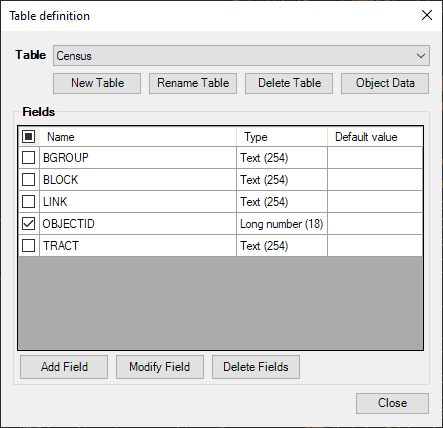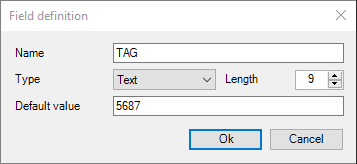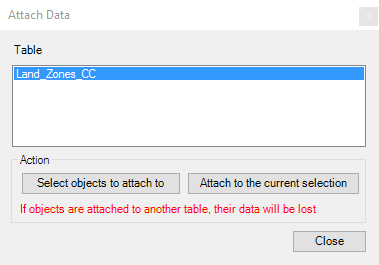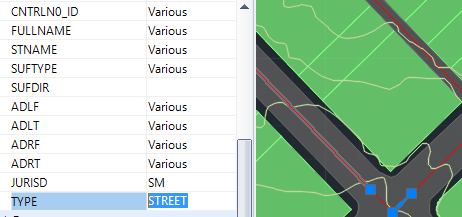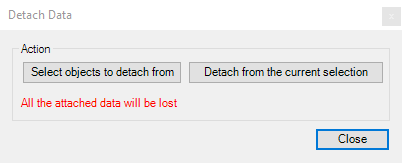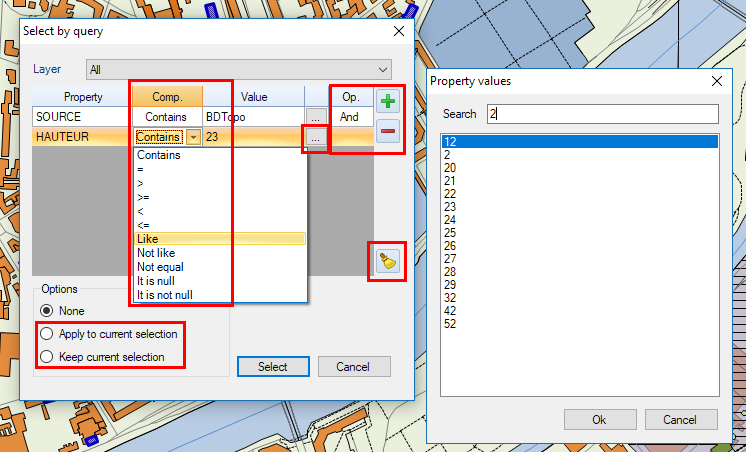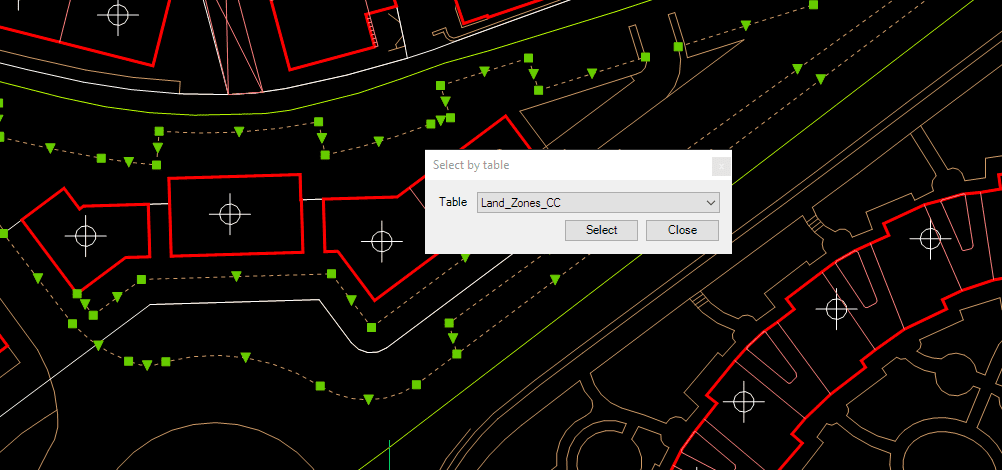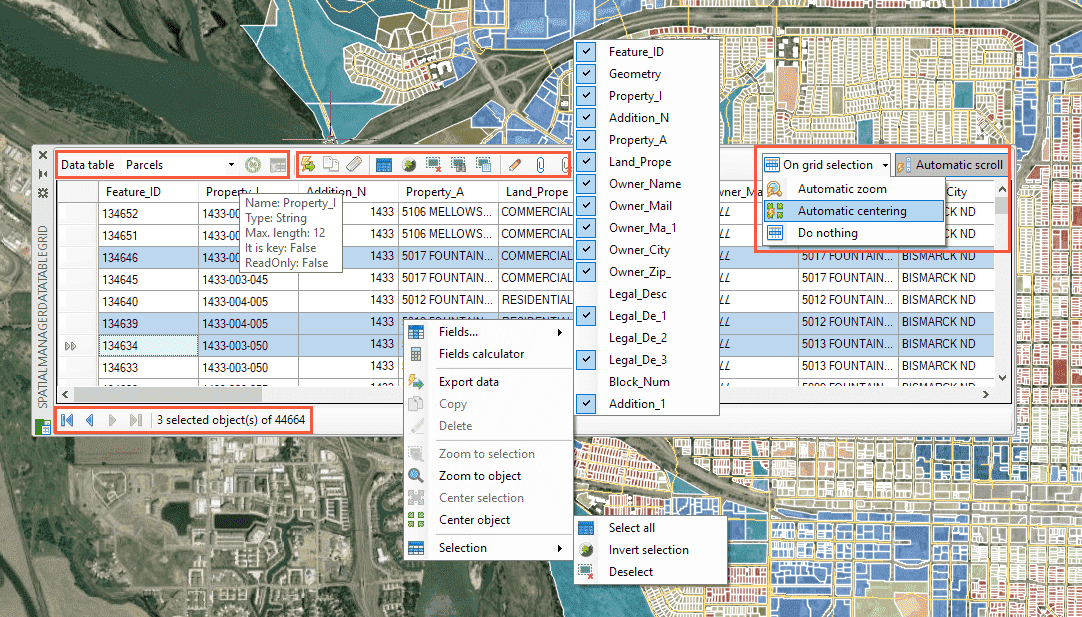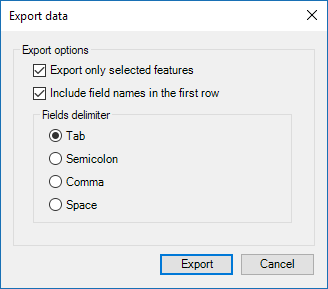Difference between revisions of "Spatial Manager™ for AutoCAD - FAQs: Data Structure Management ("Standard" and "Professional" editions only)"
m |
m |
||
| (2 intermediate revisions by the same user not shown) | |||
| Line 1: | Line 1: | ||
| + | [[image:SPM AutoCAD Wiki to Website.png|150px|link=http://www.spatialmanager.com/spm-forautocad/ |Spatial Manager™ for AutoCAD product page]] [[image:SPM AutoCAD Wiki to Download.png|150px|link=http://www.spatialmanager.com/download/spatial-manager-autocad/ |Download Spatial Manager™ for AutoCAD]] | ||
| + | |||
| + | |||
| + | |||
===Introduction=== | ===Introduction=== | ||
*'''Objective of this section''' | *'''Objective of this section''' | ||
| Line 165: | Line 169: | ||
===Can I view and edit the objects data in a table form? ("Professional" edition only)=== | ===Can I view and edit the objects data in a table form? ("Professional" edition only)=== | ||
| − | Yes, the command 'SPMDATATABLEGRID' of Spatial Manager™ for AutoCAD opens | + | Yes, the command 'SPMDATATABLEGRID' of Spatial Manager™ for AutoCAD opens the 'Data Grid' palette where you can view, edit, etc. the objects data in any table in the drawing. You can also select objects from the 'Data Grid', export the data from the tables and more |
| Line 236: | Line 240: | ||
*[http://www.spatialmanager.com/retrieve-existing-data-values-when-querying/ Retrieve existing data values when querying] | *[http://www.spatialmanager.com/retrieve-existing-data-values-when-querying/ Retrieve existing data values when querying] | ||
*[http://www.spatialmanager.com/analysis-of-parcels-crossed-by-a-road/ Analysis of parcels crossed by a road] | *[http://www.spatialmanager.com/analysis-of-parcels-crossed-by-a-road/ Analysis of parcels crossed by a road] | ||
| + | *[http://www.spatialmanager.com/roads-and-streets-profiles-from-your-dwgs-or-maps-2/ Geodata from AutoCAD to AutoCAD Map] | ||
*[[Spatial Manager™ for AutoCAD#FAQs|Go to FAQS]] | *[[Spatial Manager™ for AutoCAD#FAQs|Go to FAQS]] | ||
| + | |||
| + | |||
| + | |||
| + | [[image:SPM AutoCAD Wiki to Website.png|150px|link=http://www.spatialmanager.com/spm-forautocad/ |Spatial Manager™ for AutoCAD product page]] [[image:SPM AutoCAD Wiki to Download.png|150px|link=http://www.spatialmanager.com/download/spatial-manager-autocad/ |Download Spatial Manager™ for AutoCAD]] | ||
Revision as of 11:51, 18 December 2019
Introduction
- Objective of this section
- To learn how to define data tables and how to attach the data to the objects in an AutoCAD drawing
- Topics in this section
- Data tables: create, restore, rename, edit or delete
- Fields in data tables: create, edit or delete. Field types
- Data grid
- Attach data to objects
- Detach data from objects
- Select objects based on their data
- Select objects in the drawing which are attached to a specific table
- Zoom to the selection
Note: Some components in the images on this page (providers, names, windows look, etc.) may be slightly different from those that will appear on your computer
- NOTE for Imported objects: keep in mind that in the Importing processes the data tables may be automatically defined and the imported objects will be automatically attached to the data tables. All everything you read here applies to these cases
- NOTE about the performance of the selections: the selection of objects in AutoCAD may be a few slower when the "SpatialManager" palette is open, depending on the data of the objects
How can I define data tables in a drawing?
The command 'SPMDATATABLEDEFINE' of Spatial Manager™ for AutoCAD lets you create new data tables in a drawing as well as modify them. Also use this command if you need to rename or delete data tables. You will find this command in the "Spatial Manager" ribbon, toolbar or drop-down menu
Table definition window
Click on the "New Table" button to create a new (empty) data table. Select a data table in the drop-down list to rename it ("Rename Table" button), delete it ("Delete Table" button) or to modify it:
- Add Field. To add a new field in the selected data table
- Name. The field name, unique in the selected data table
- Type. You can select the field type in the drop-down list: Text, Integer, Date, etc. The field type cannot be changed if you want to modify the field later
- Default value. The default value for this field when the corresponding data table is attached to one or more objects
- Modify Field. To edit the selected field of the selected data table (view "Add Field" above)
- Delete Field. To delete the selected field of the selected data table
Note: In brackets the Length of the Field (and the number of decimal places, when applicable)
Add / Modify field window
The following is the behavior of the application when you modify a data table which is already attached to one or more objects in the drawing:
- Adding a field: the new field is added to all the attached objects. If a "Default value" has been defined for the field, this will be the value assigned to the field for these objects
- Modifying a field: only the name of the field (if modified) will be changed for all the attached objects
- Deleting a field: the field will be erased for all the attached objects
As you can see in the Tables selection dropdown, there is a "scan new tables..." option to retrieve data Table structures from the drawing objects. This is useful when "Copying/Cutting and Pasting" objects from one drawing to another, when saving drawings using WBLOCK, when inserting a drawing into another, etc.
How to attach a data table to one or more objects?
When you want to attach an existing data table to one or more objects in the drawing, you can execute the command 'SPMDATATABLEATTACH' of Spatial Manager™ for AutoCAD. You will find this command in the "Spatial Manager" AutoCAD ribbon
First, choose a data table in the list of defined data tables in the command window. Then, the attach operation can be applied to the selected objects (if any) or to a new objects selection
WARNING: An object can be attached to one data table only, so if you attach it to a new data table the previously data attached to this object (if any) WILL BE LOST
How can I modify the objects data?
You can directly edit a data field value (XDATA / EED Direct data edition) for one or more objects in Spatial Manager™ for AutoCAD by selecting the object(s) in the drawing and typing the new value for this field in the "Properties" area of the "SpatialManager" palette. You can also delete the field content to get a null value in this field. To validate any modification, you need to press Enter or click on a different field
Notes:
- The fields whose value starts with "http" are automatically converted into active links
- Because of performance considerations, the number of objects selected for which their data are shown in the application palette is limited by the system variable PROPOBJLIMIT (AutoCAD 2012 and upper) or to 25000 (AutoCAD 2008 to 2011)
Is there any way to detach the data from the objects?
Yes, you can detach any data from one or more objects by executing the command 'SPMDATATABLEDETACH' of Spatial Manager™ for AutoCAD. You will find this command in the "Spatial Manager" AutoCAD ribbon
The detach operation can be applied to the selected objects (if any) or to a new objects selection
WARNING: All the current data attached to the objects (if any) WILL BE LOST
Can I define a selection of objects based on the values of their data?
The command 'SPMSELECTBYQUERY' in 'Spatial Manager™ for AutoCAD' allows you select objects in the drawing according to the result of a simplex or compound data query
- The query can be applied to one data table or to all the data tables defined in the drawing
- Click on the "+" button to add at least one condition and so create a data query (a condition that stands for "Property & Comparator & Value")
- When you are defining a compound query, you can add as many conditions as you want to the conditions list . Click on the "+" button each time you need to add a condition
- You can select the logical operators "And" or "Or" when adding new conditions. "And" will be the default operator
- In addition, if there is any object selected when you run the command, you can:
- Apply the query to the current selection, and not to the entire drawing, or,
- Keep the current selection so the new "query selection" will be added to the current selection
- Notes:
- You can choose and search (...) among the available values for a Field
- The command keeps the list of query conditions used the last time it was executed
- If there are no results during a query, the command window is shown again and keeps the list of query conditions
- You can use the "-" button every time you need to remove a condition from the conditions list in the query, or you can use the Clean button (the "broom") to remove all query conditions from the list
You can use the command 'SPMZOOMTOSELECTION' (see below) to quickly zoom into the selection extent
Can I select all the objects attached to the same data table?
Yes, you can select all the objects which have been previously attached to a specific data table. To do that, execute the command 'SPMSELECTBYTABLE' of Spatial Manager™ for AutoCAD. You will find this command in the "Spatial Manager" AutoCAD ribbon
To choose the one you want, click on the data tables drop-down list
Note: You can use the command 'SPMZOOMTOSELECTION' (see below) to quickly zoom to the selection extent
Is there any way to locate on the screen all the selected objects?
Yes, the 'Spatial Manager™ for AutoCAD' 'SPMZOOMTOSELECTION' command, zooms to the current selection extent so you can locate all the selected objects in an optimal size view
Note: This functionality can be very handy as a complement to the two previous selection commands, but also if it is used with other AutoCAD selection functions
Can I view and edit the objects data in a table form? ("Professional" edition only)
Yes, the command 'SPMDATATABLEGRID' of Spatial Manager™ for AutoCAD opens the 'Data Grid' palette where you can view, edit, etc. the objects data in any table in the drawing. You can also select objects from the 'Data Grid', export the data from the tables and more
Like any AutoCAD palette, the 'Data Grid' palette can be arranged, docked, undocked, grouped, self-collapsed, etc., and resized, depending on the preferences and needs of each user or each job, by dragging its title bar, double-clicking on its title bar, etc.
- To choose the drawing data table that you want to show in the 'Data Grid', you can use the drop-down list of available tables that can be found in the palette upper left area
- You can select which table fields you want to display in the 'Data Grid' by right-clicking on any grid area
- You can move the field separation lines in the table header to change the width of the corresponding column
- A double click on this vertical line (always in the table header) will automatically adjust the corresponding column width to the dimension of the longest value in that field
- If the value of a field in a given row cannot be seen as complete due to the width of the column, placing the cursor over the corresponding cell will display a tooltip displaying the full value in that cell. The same applies to the names of the fields in the table header
- To sort the values of a column alphabetically, click on the column name in the table header. A second click will invert the sorting
- To move and sort the fields (columns) in the table you can drag the field name itself in the table header to the left or right
- If you hover the cursor in the table header over the name of a field, a tooltip with information about the properties of that field (Name, Type, Length, etc.) will be displayed (except when the incomplete name of a field is displayed as a tooltip - see above)
- The 'Data Grid' is automatically synchronized with the current drawing
- You can select objects in the drawing in order to highlight the corresponding attached rows in the 'Data Grid'
- If the "Automatic scroll" option (palette upper right area) is activated, the rows will be automatically scrolled to show the selected objects
- You can also select rows in the 'Data Grid' in order to select the corresponding attached objects in the drawing. You can use the CTRL and SHIFT keys (alone or in combination) when you want to select multiple rows
- If the "Automatic zoom" option (palette upper right area) is activated, the drawing view will be adjusted to the selected objects extent
- Use "Zoom to selection" (right-click menu) at any time if you want to do the same thing by hand, or "Zoom to object" if you only want to zoom to the object under the cursor in the grid when right-clicking
- If the "Automatic centering" option (palette upper right area) is activated, the drawing view will be centered on the selected objects without modifying the zoom level
- Use "Center selection" (right-click menu) at any time if you want to do the same thing by hand, or "Center object" if you only want to center the object under the cursor in the grid when right-clicking
- As long as you are focused on the grid rows, you can use the keyboard (Up, Down, CTRL+Up, etc.) to navigate through the rows, and the SPACE key to select rows (you will see a small "tick" checked on the row header when you select it)
- Use the selection functions (buttons set on top of the palette / right-click menu) if you want to Select All objects attached to the current table, Invert the selected objects (see note below) or Deselect all selected objects
- If the "Automatic zoom" option (palette upper right area) is activated, the drawing view will be adjusted to the selected objects extent
- Use "Delete" (buttons set on top of the palette / right-click menu) to delete selected objects and their data from the drawing (see note below)
- You can find information about the number of selected objects and the total number of objects, as well as navigation buttons between the rows selected in the table, in the palette lower left area
- Under some circumstances, synchronization may be lost. To resynchronize drawing and 'Data Grid', use the "Refresh" button next to the tables dropdown (upper left area of the palette)
- For application performance reasons, sometimes a warning will be displayed to indicate that you need to manually refresh the 'Data Grid'. For example, this may happen when a very large number of objects are deleted in the drawing
- Also for performance reasons, the selection of objects may need to use the "Activate table of selected objects" button, located to the right of the previous one, in order to update the table shown in the data grid
- If this button is enabled, the table shown in the grid is not attached to any of the selected objects. Pressing it will display the table attached to the selected object, or to one of the selected objects if there are more than one
- When the button is disabled, the table shown in the grid is the table attached to one of the selected objects, or none of the selected objects are attached to any table
- You can select objects in the drawing in order to highlight the corresponding attached rows in the 'Data Grid'
- To edit the value in a cell, simply double-click on the cell. You can also click or press ENTER on the "active" cell to edit its value. To finish the edition, press the ENTER key or the TAB key (edit next field in the same row), or select any other cell or row in the table. To cancel editing, press the ESC key
- Pressing CTRL+ENTER will allow you to assign the current value in a cell to all cells in the same column for all selected rows
- Pressing SHIFT+ENTER will allow you to assign the current value in a cell to all cells in the same column for all rows
- You can export to an ASCII file the data in the whole table or in the selected rows only by running "Export" (buttons set on top of the palette / right-click menu)
- As you will see, you can include the field names in the export process and choose the field delimiter and the extension of the exported file
- Alternatively you can copy the table information to the Windows clipboard by using "Copy" (buttons set on top of the palette / right-click menu) or by pressing CTRL+C
- The selected rows and headers (field names) will be copied in a tab-separated format, suitable for pasting into a spreadsheet, ASCII editor, etc.
- As an exception, if a field is being edited (see above), only the value of this field will be copied to the clipboard
- From the buttons set on top of the palette you can also directly access the tables main management commands
- Select by query (SPMSELECTBYQUERY)
- Select by table (SPMSELECTBYTABLE)
- Define table (SPMDATATABLEDEFINE)
- Attach (SPMDATATABLEATTACH)
- Detach (SPMDATATABLEDETACH)
- Notes:
- When you use grid functions that affect selected objects (Invert, Delete, etc.), the selection refers only to those objects linked to the current table. For example when Deleting, the objects selected in the current table will be deleted but not other objects selected in the drawing (if any), which will be deselected before the deletion operation
- The "Feature_ID" column in the tables indicates the AutoCAD Handle of the object (unique and unrepeatable for each object in the drawing). These values cannot be edited
- If a table to which objects in the drawing are attached does not appear in the table drop-down list, try to "Restore" tables as these objects may be in the drawing after copying-pasting between drawings, inserting one drawing into another, etc.
- If closed, the application will automatically open the 'Data Grid' palette the first time you import any data source that includes a data table (EED/XDATA)
Related links
- Data Structure Management – Create, Modify, Select, Delete
- Selecting by queries in AutoCAD and BricsCAD
- The new Data Grid
- Scan and recovery of data tables from drawing objects
- Retrieve existing data values when querying
- Analysis of parcels crossed by a road
- Geodata from AutoCAD to AutoCAD Map

